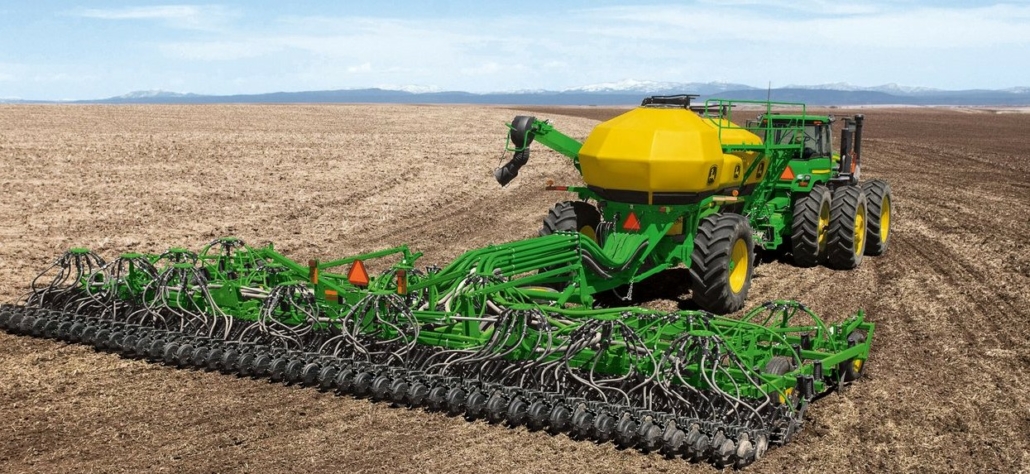@Smokin Joe
Frankly,I don't see how family farms can even survive anymore,give the insanely high cost of farm equipment,and the fact that it is almost impossible anymore to hire seasonal farm workers at all,never mind hire any that aren't drunks.
And there is no getting around it,the days of a guy with a small tractor plowing to plant seed with a bandana tied around his face to keep from inhaling all the dust,and a umbrella mounted to a fender to try to provide him with some shade are OVER.
I don't even see how family farms that have existed for generations can make any profits anymore. Sure,you can buy computer-controlled farm equipment that will do all the planting and picking,but if you have enough money to buy a couple of them,why they hell are you farming?
What I see are family farms shutting down as the farm children no longer want to farm,they want to work in offices. The farm land gets sold out to developers who are building houses for sale,and everybody involved is getting too rich to even think about working in the dirt.
I see the future of farming as mega-corporation farms being the rule instead of the exception.
Planting rigs look a lot more like this,

, usually with a tank trailer full of anhydrous ammonia in there somewhere. The farms have grown from the consolidation of original homestead blocks, usually through marriage or through a neighbor selling out and being absorbed. Additional acreage is sometimes leased from folks who don't want to farm it but don't want to sell it either. Wheat farms are measured in sections, a section being roughly a square mile. I have known folks who farmed as many as 17 sections. Nowadays, GPS setups keep the operator from missing or double planting land, so the best use is made of everything, from fuel to seed to fertilizer, and yes, time. Some setups will even steer the tractor.
Out here, in the oil producing counties, the farmers have a secret weapon: mineral rights. In some of the counties in this end of the state, oil has been found since the 1950s. For those who kept their mineral rights, in the recent boom, lease fees per acre went as high a $5,000 in some areas, a nice injection of cash that made purchasing the sort of equipment you see in the pic possible. It is not unusual for there to be a million dollars' worth of equipment on the farm or more, especially when you count in grain storage and a semi or two to haul it to elevators for sale. This is multi-generational wealth, in its truest sense, and operated as a business by family members who are careful who they pass it on to.
For farm families just starting up, they start small, and I have heard drillers in the oil patch joking (sorta) in bad ag price years that they were glad they had a job in the oil patch so they could afford to farm a while longer. But that's in the more conservative western part of the State, where farming and ranching differ from the East side, and mostly dry land farming.
In Eastern North Dakota, there was a lake, Lake Agassiz, which existed when the glacial ice sheets backed up water from north of the Canadian Border to south of Fargo and beyond. When the Ice melted away, the lake drained off to the North, and it left behind some incredibly rich farmland, and one of the flattest spots on earth: the old lake bottom, now known as the Red River Valley, for the Red River of the North which runs through it. While you can grow wheat on that land, it is better put to use growing potatoes or sugar beets, and those crops have a higher cash value per acre than wheat, and require different equipment. Labor (mainly truck drivers) are hired for the harvest season only, and I know guys who work the sugar beet harvest as a way to boost their income every year. (Sugar beets are also grown in the bottom land next to the Yellowstone and Missouri rivers near the confluence). Itinerant folks keep the weeds down, and often don't speak English very well--although some programs were set up to teach them and their kids, who will work alongside their parents, much like we worked the family farm when we were kids.
To get started farming, many will grow livestock, because the equipment hasn't changed that much in the last fifty years, they can get used equipment at auction or buy it from another farmer, and get by and build the sort of operation that they want, always with an eye on the next generation. If you are farming, you'd better be a mechanic, too. and yes, all spend some time with lawyers and financial planners figuring out ways to shelter their farms from the taxman, both while they are alive and after they are gone. Sometimes, that start can be on a relatively small patch of ground, and specialty crops are the ticket there, from squash blossoms to ship out air freight to five star restaurants to Echinacea for the herb and supplement industry, those niche crops can provide an income and for the fiscally conservative, a leg up into bigger things.
Some times that doesn't work, because as you said, the kids don't want to farm. I know of one guy who literally lost the ranch when his siblings were left equal shares and they (who moved to the west coast and never had a hand in ranch operations as adults) outvoted their brother who had stayed on the ranch, worked it, and even cared for their mom while she was dying of cancer.
They saw dollar signs, voted to sell, and he saw his way of life stripped from him because 1/3 of that operation wasn't big enough to survive, financially. So that happens, too.